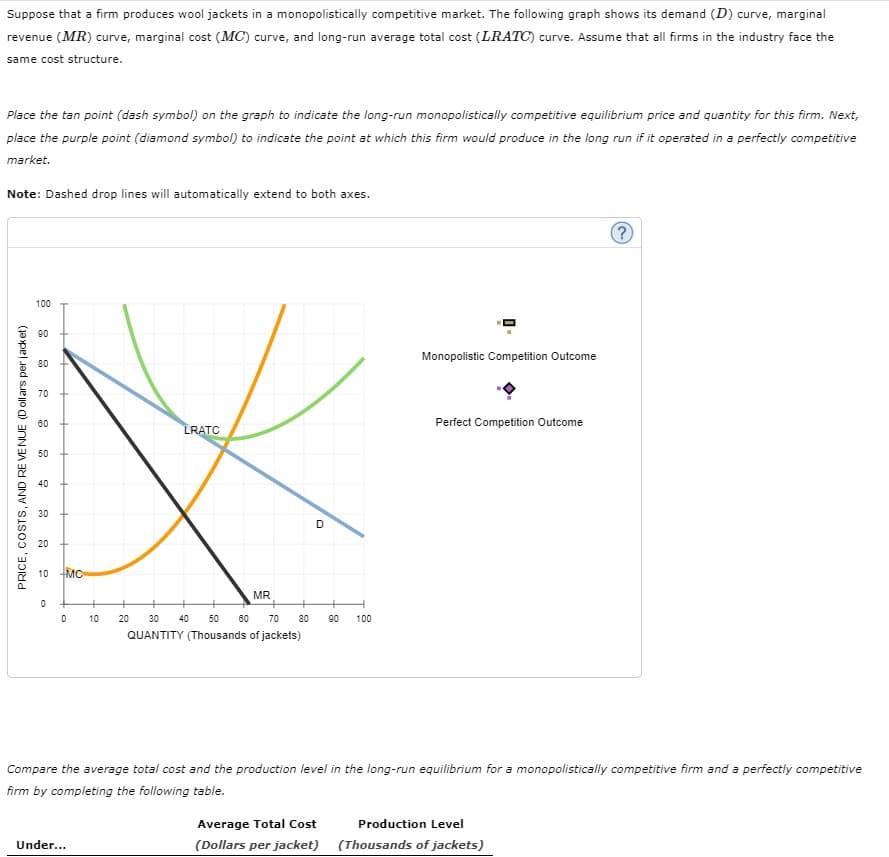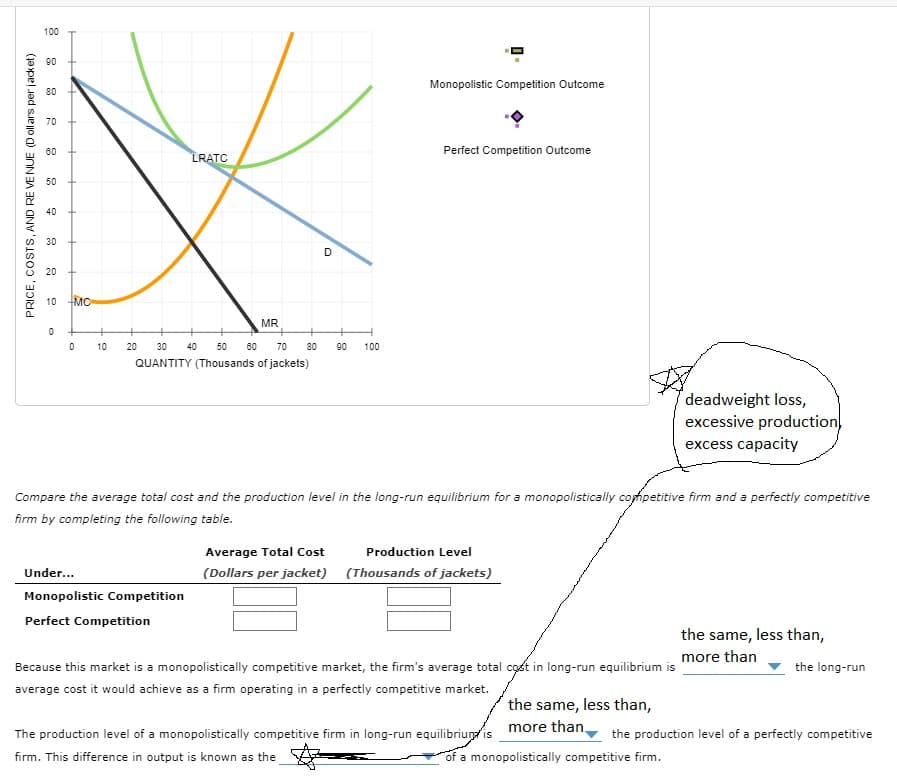Suppose that a firm produces wool jackets in a monopolistically competitive market. The following graph shows its demand (D) curve, marginal revenue (MR) curve, marginal cost (MC) curve, and long-run average total cost (LRATC) curve. Assume that all firms in the industry face the same cost structure. Place the tan point (dash symbol) on the graph to indicate the long-run monopolistically competitive equilibrium price and quantity for this firm. Next, place the purple point (diamond symbol) to indicate the point at which this firm would produce in the long run if it operated in a perfectly competitive market. Note: Dashed drop lines will automatically extend to both axes. 100 90 Monopolistic Competition Outcome 80 70 60 Perfect Competition Outcome LRATC 50 40 30 D 20 10 MC MR 10 20 30 40 50 60 70 80 90 100 QUANTITY (Thousands of jackets) PRICE, COSTS, AND RE VENUE (D oll ars per jacket)
Suppose that a firm produces wool jackets in a monopolistically competitive market. The following graph shows its demand (D) curve, marginal revenue (MR) curve, marginal cost (MC) curve, and long-run average total cost (LRATC) curve. Assume that all firms in the industry face the same cost structure. Place the tan point (dash symbol) on the graph to indicate the long-run monopolistically competitive equilibrium price and quantity for this firm. Next, place the purple point (diamond symbol) to indicate the point at which this firm would produce in the long run if it operated in a perfectly competitive market. Note: Dashed drop lines will automatically extend to both axes. 100 90 Monopolistic Competition Outcome 80 70 60 Perfect Competition Outcome LRATC 50 40 30 D 20 10 MC MR 10 20 30 40 50 60 70 80 90 100 QUANTITY (Thousands of jackets) PRICE, COSTS, AND RE VENUE (D oll ars per jacket)
Microeconomics A Contemporary Intro
10th Edition
ISBN:9781285635101
Author:MCEACHERN
Publisher:MCEACHERN
Chapter10: Monopolistic Competition And Oligopoly
Section: Chapter Questions
Problem 11PAE
Related questions
Question
100%
the choices for the last one is circled,
also please do the grph too
thank uuuu

Transcribed Image Text:Suppose that a firm produces wool jackets in a monopolistically competitive market. The following graph shows its demand (D) curve, marginal
revenue (MR) curve, marginal cost (MC) curve, and long-run average total cost (LRATC) curve. Assume that all firms in the industry face the
same cost structure.
Place the tan point (dash symbol) on the graph to indicate the long-run monopolistically competitive equilibrium price and quantity for this firm. Next,
place the purple point (diamond symbol) to indicate the point at which this firm would produce in the long run if it operated in a perfectly competitive
market.
Note: Dashed drop lines will automatically extend to both axes.
100
90
Monopolistic Competition Outcome
80
70
60
Perfect Competition Outcome
LRATC
50
40
30
D
20
10
MC
MR
10
20
30 40 50
80
70
80
90
100
QUANTITY (Thousands of jackets)
Compare the average total cost and the production level in the long-run equilibrium for a monopolistically competitive firm and a perfectly competitive
firm by completing the following table.
Average Total Cost
Production Level
Under...
(Dollars per jacket) (Thousands of jackets)
PRICE, COSTS, AND RE VE NUE (D oll ars per jacket)

Transcribed Image Text:100
90
Monopolistic Competition Outcome
80
70
60
Perfect Competition Outcome
LRATC
50
40
30
D
20
10
MC
MR
10
20
30
40
50
60
70
80
90
100
QUANTITY (Thousands of jackets)
deadweight loss,
excessive production,
excess capacity
Compare the average total cost and the production level in the long-run equilibrium for a monopolistically cophpetitive firm and a perfectly competitive
firm by completing the following table.
Average Total Cost
Production Level
Under...
(Dollars per jacket)
(Thousands of jackets)
Monopolistic Competition
Perfect Competition
the same, less than,
more than
Because this market is a monopolistically competitive market, the firm's average total cost in long-run equilibrium is
the long-run
average cost it would achieve as a firm operating in a perfectly competitive market.
the same, less than,
more than
The production level of a monopolistically competitive firm in long-run equilibriun is
firm. This difference in output is known as the
the production level of a perfectly competitive
of a monopolistically competitive firm.
PRICE, COSTS, AND RE VE NUE (D oll ars per jacket)
Expert Solution
This question has been solved!
Explore an expertly crafted, step-by-step solution for a thorough understanding of key concepts.
This is a popular solution!
Trending now
This is a popular solution!
Step by step
Solved in 2 steps with 1 images

Knowledge Booster
Learn more about
Need a deep-dive on the concept behind this application? Look no further. Learn more about this topic, economics and related others by exploring similar questions and additional content below.Recommended textbooks for you








Exploring Economics
Economics
ISBN:
9781544336329
Author:
Robert L. Sexton
Publisher:
SAGE Publications, Inc

Managerial Economics: Applications, Strategies an…
Economics
ISBN:
9781305506381
Author:
James R. McGuigan, R. Charles Moyer, Frederick H.deB. Harris
Publisher:
Cengage Learning